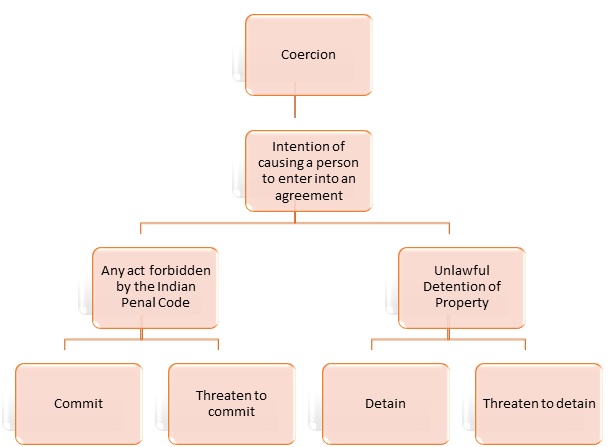Free Consent - Misrepresentation
Misrepresentation is defined by section 18 of the ICA,1872 as,
“Misrepresentation” means and
includes—
(1) the positive assertion, in a
manner not warranted by the information of the person making it, of that which
is not true, though he believes it to be true;
(2) any breach of duty which,
without an intent to deceive, gains an advantage of the person committing it,
or any one claiming under him, by misleading another to his prejudice or to the
prejudice, of any one claiming under him;
(3) causing, however innocently,
a party to an agreement, to make a mistake as to the substance of the thing
which is the subject of the agreement.”
Similar to fraud, the definition
of misrepresentation is also an exhaustive one. The definition includes three
acts which if committed would amount to misrepresentation with one common
factor i.e. an innocent intention contrary to that in fraud i.e. a fraudulent
intention.
MEANING
Before moving to understand the general meaning of misrepresentation, it is vital to understand what
constitutes as ‘representation’. Representation refers to assertions made
explicitly by affirmation, denial or description or even implied through
conduct (nod, shake of head, facial gestures, wink, hand gestures, etc). Misrepresentation
is defined by the Black’s Law Dictionary as,
“Any manifestation by words
or other conduct, by one person to another that, under the given circumstances,
amounts to an assertion not in accordance with the facts. An untrue statement
of fact, an incorrect and false representation, that which, if accepted, leads
the mind to an apprehension of a condition other and different from the one
which exists.”
The Cambridge dictionary defines
it as “something that misrepresents an idea, situation, or opinion, or the
fact of something being misrepresented”.
Therefore, anything that
misleads a party to believe something which is not true can be referred to as
misrepresentation.
I.
Unwarranted positive assertion
A statement having a reliable
source of authority is a warranted statement. An assertion that is made with
knowledge from any untrustworthy source is an unwarranted assertion. A positive
statement made by a person without actually knowing the truth but believing it
to be the truth is a misrepresentation. For example, an assertion based upon a
mere hearsay. In Mohanlal v. Sri Gungaji Cotton Mills Co ((1899-90) 4 CWN 369),
A told the plaintiff that B would be the director of a company. He obtained
this information not from B himself but from another person C. The plaintiff
purchased some shares in that company believing A’s statement to be true. The
assertion was false. Judge McLean held that,
“A says that C told him that
he, C had authority from B to use his name in the prospectus as a director, in
other words, that he A obtained his information not from B direct, but only
through C. I am not disposed to think that if A had relied on the second
hand information he derived from C, he was “warranted” in making the positive
assertion that B would be a director.”
II.
Unintentional Breach of duty
The duty referred to under this
clause is similar to the ‘duty to speak’ discussed in the previous article. If the parties have
such a fiduciary relationship where one party(A) has the duty to communicate
any material fact to the other(B), then any breach which misleads B to believe
something and benefits A, even if it is unintentional is a misrepresentation. For
example, Dr. Grey was going to buy the medical practice of Dr. Karev which
initially had the value of GBP 2000 a year. But before, Dr. Grey took
possession the value dropped to a mere GBP 5 per week which was known to Dr.
Karev. Dr. Karev did not communicate this to Dr. Grey. Since the whole sale relied upon the value of the practice and the first representation about the value of the practice was intended to induce the sale, Dr Grey proceeded with the sale believing the first representation about the value to be still true. Here, Dr. Karev had the
duty to communicate this material information of the change of circumstances to Dr. Grey. He committed a
breach by not disclosing this information and thus this amounted to
misrepresentation. (With v. Flanagan, [1936] ChD 575)
A landmark case that explains
this clause is the case of Oriental Bank Corporation v. John Fleming (ILR
(1879) 3 Bom 242). In this case, the plaintiff signed a deed without reading
the terms of the agreement on the assurance of the defendants that the deed comprises
of the terms that were previously agreed by the plaintiff. It was later found
that it was instead a release deed in favour of the defendants. The deed was
set aside by the court. It held that
“the defendant was under no obligation,
legally or morally, to communicate the contents of the deed. But the plaintiff
placed confidence. It then became his duty to state fully without concealment,
all that was essential to a knowledge of the contents of a document”.
The court further clarifying the
intent of section 18(2) said that
“the second clause of section
18 is probably intended to meet all those cases which are called in the Courts
of Equity, perhaps unfortunately so, cases of “constructive fraud”, in which
there is no intention to deceive, but where the circumstances are such as to
make the party who derives a benefit from the transaction equally answerable in
effect as if he had been actuated by motives of fraud or deceit”.
III.
Induced Mistake of subject matter
If any party misleads another,
innocently, to misunderstand about the value, nature or quality of the subject
matter of an agreement is said to cause misrepresentation. Consider the
following situation - The agents of a company
signed a bill of exchange in a form which would not ensue liability on the company and sold it to the bank. The bank was unaware of the form in which it was
drawn. The court held that the agents acting in their authority had sold the
bill as one on which the company will be liable but due to the form in which it
was drawn, the company could not be held liable. The agents of the company were, therefore, guilty of misrepresentation. (Nursey Spinning and Weaving Co
(Re), ILR (1880) 5 Bom 92)
SUPPRESSION OF VITAL FACTS
Suppression of material or vital
facts can also lead to misrepresentation. This is usually covered under clause
(2) and clause (3) of section 18. A fact is material or vital if it is capable
of affecting the decision of a rational person to enter into a contract. For
example, in a contract for sale of certain goods; the age, nature, quality of
the goods – all are to be considered as material facts; or in a contract for marriage, the qualifications, health, capacity to procreate are considered to be material facts. Consider this case, R
v. Kylsant, (1932) 1 KB 442), wherein the prospectus of a company
represented that the company regularly paid dividends which reflected that the
company was in profits. However, the company was in losses and the dividends
were being paid out of profits accumulated during wartime. The company was held
guilty of misrepresentation.
REMEDIES
If the consent of a party to a
contract is induced by misrepresentation, then the party has the option to
either rescind the contract or enforce the contract and put him in such a
position if the representation made were true (Section 19). The exception and
explanation of section 19 however indicate that the contract will be valid in
any of the two following cases-
1.
If the party had the means of discovering the truth
through ordinary diligence.
2.
If the false representation had no effect on the consent
of the party.
DISTINCTION
BETWEEN FRAUD AND MISREPRESENTATION
Fraud
and misrepresentation are very similar in terms of their construct. However, under
the Indian Contract Law, two primary differences can be spotted between them-
1.
Fraud is intentional
false representation whereas misrepresentation is innocent false
representation.
2.
Fraud is also a
tort for which damages can be claimed whereas misrepresentation is not a
tort but damages for misrepresentation can be claimed under section 75 of
the Indian Contract Act, 1872 if the contract is rescinded by the aggrieved
party.
BY
LAWVASTUTAH
REFERENCES
- Indian Contract Act, 1872
- Pollock & Mulla, The Indian Contract and
Specific Relief Acts, 16th edition.
- Avtar Singh, Contract and Specific Relief,
12th edition.
- Halsbury’s Laws of India Contract, 2e 2015.



Comments
Post a Comment